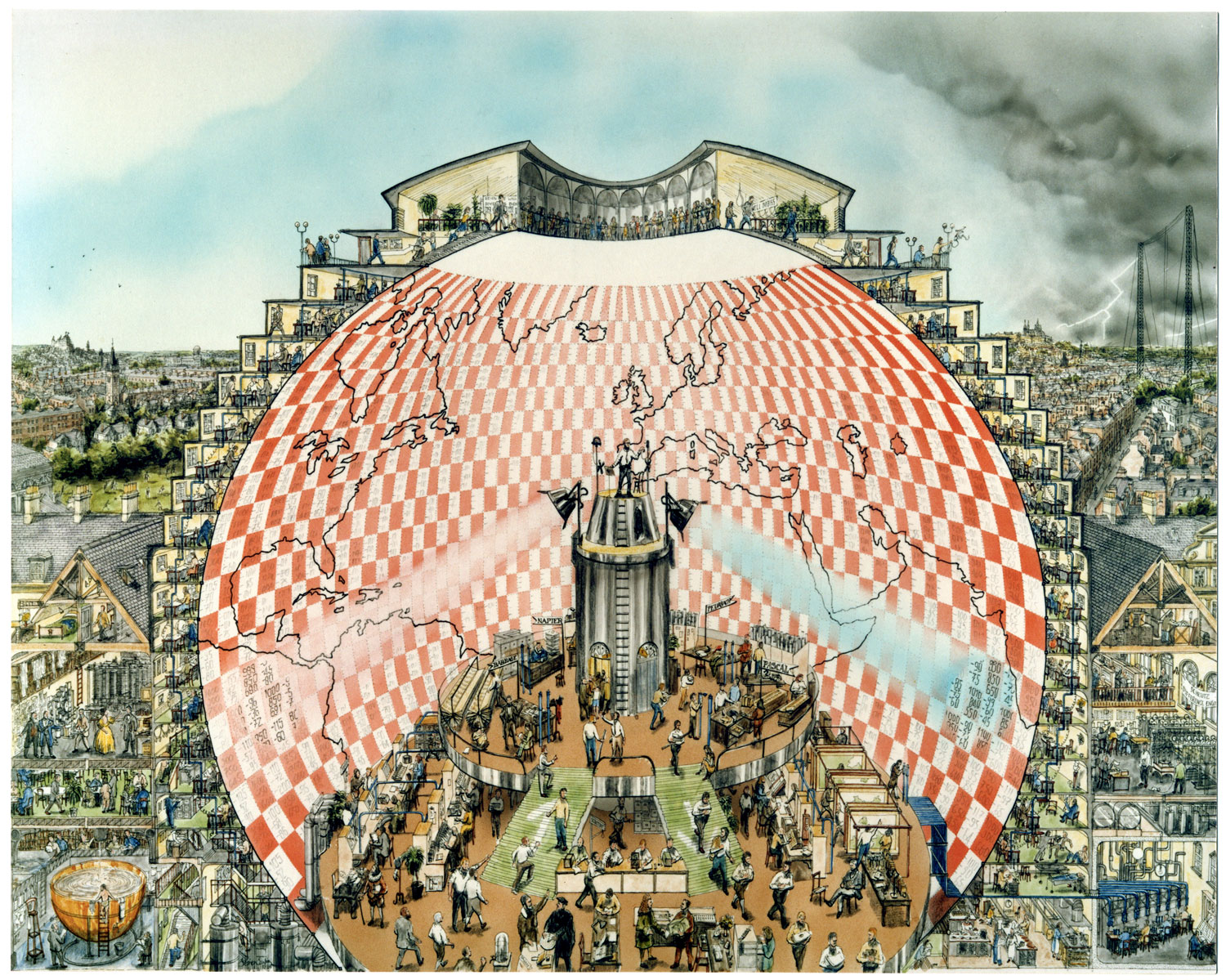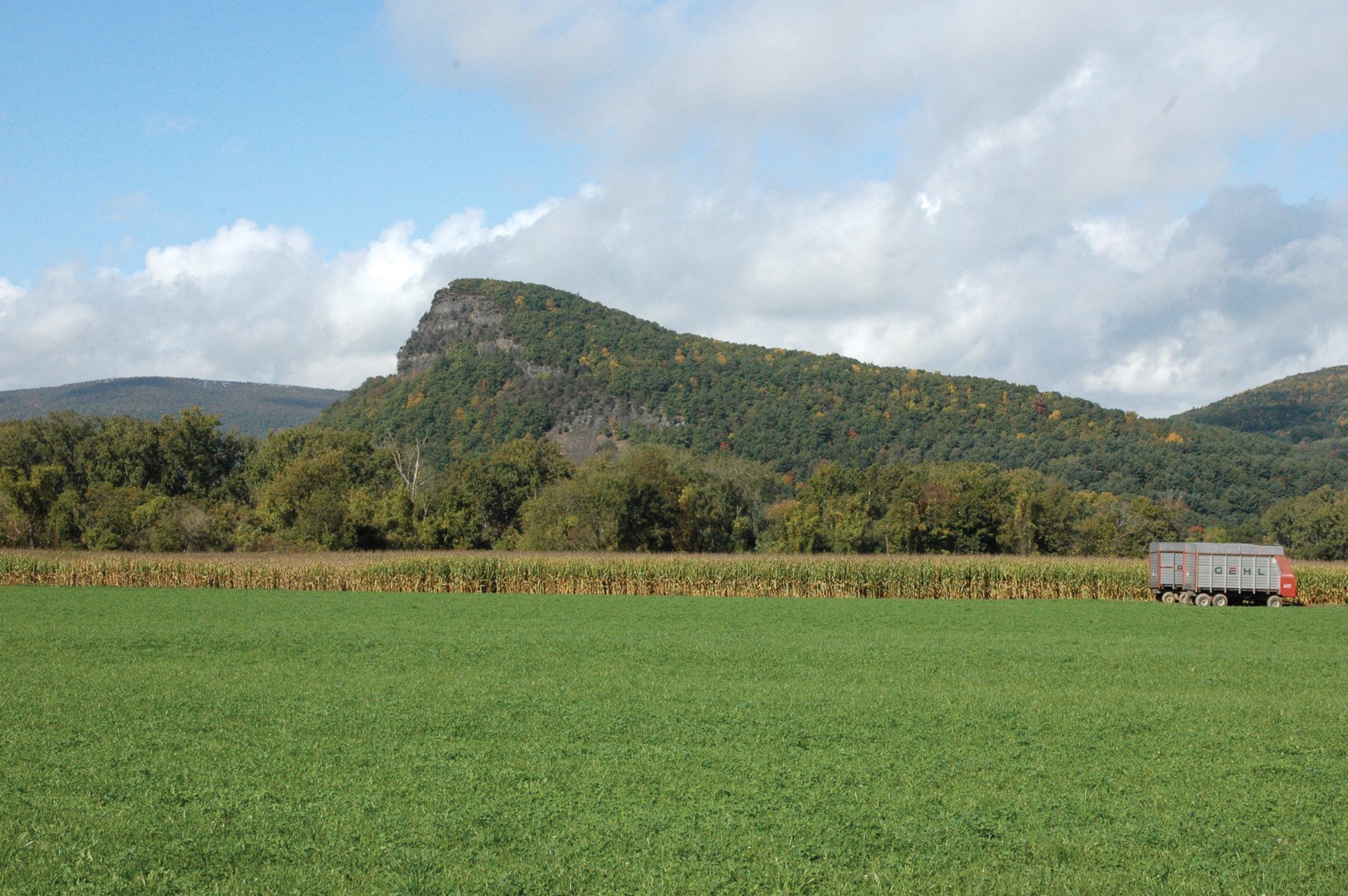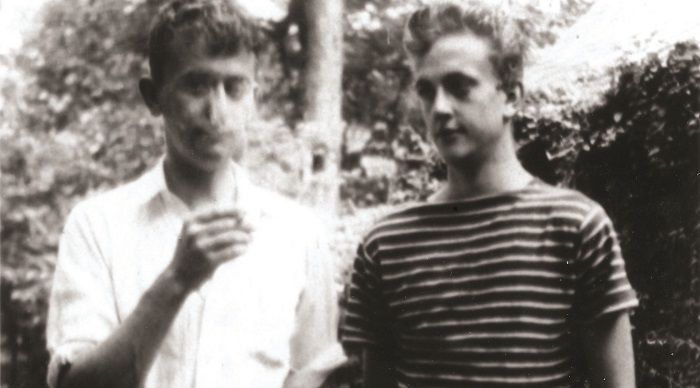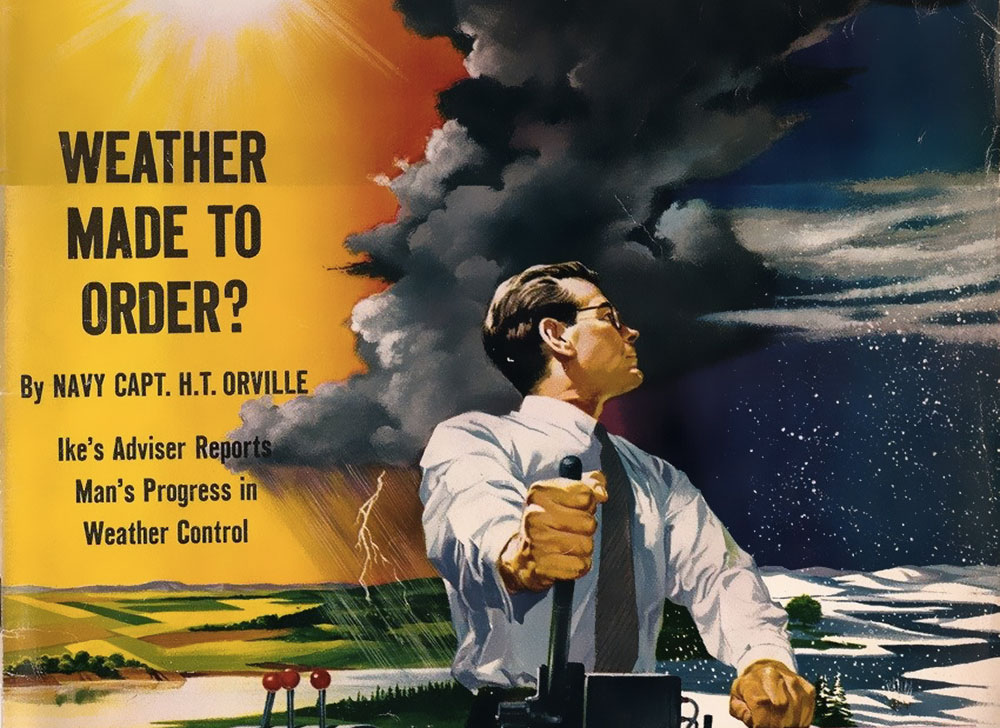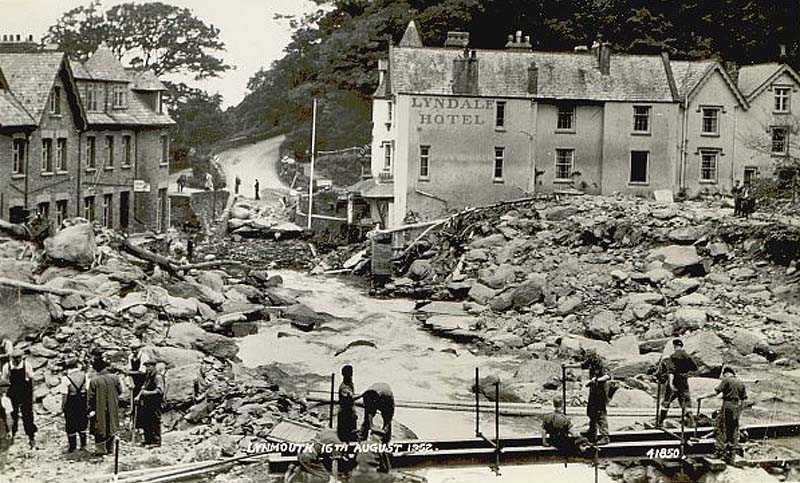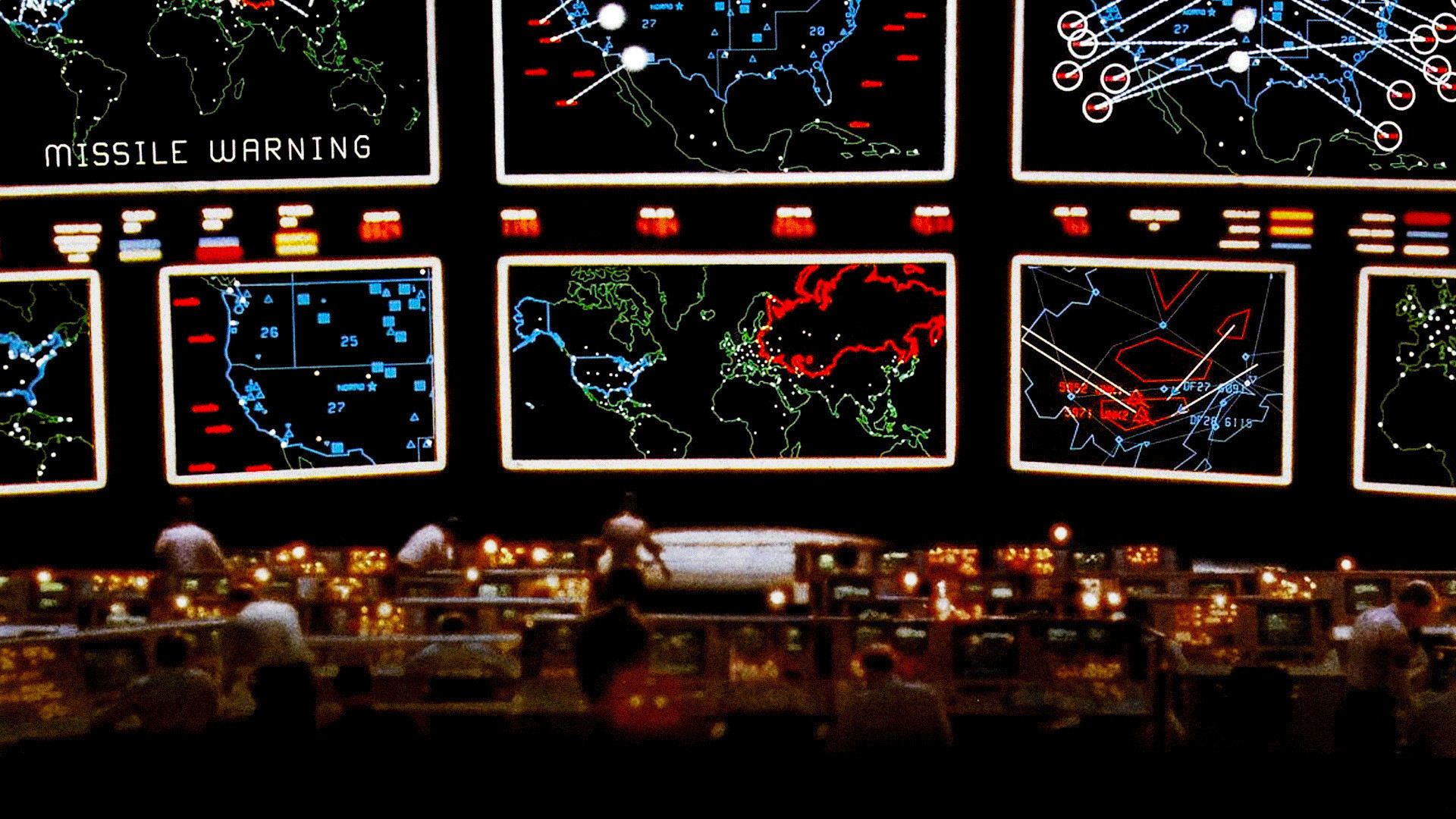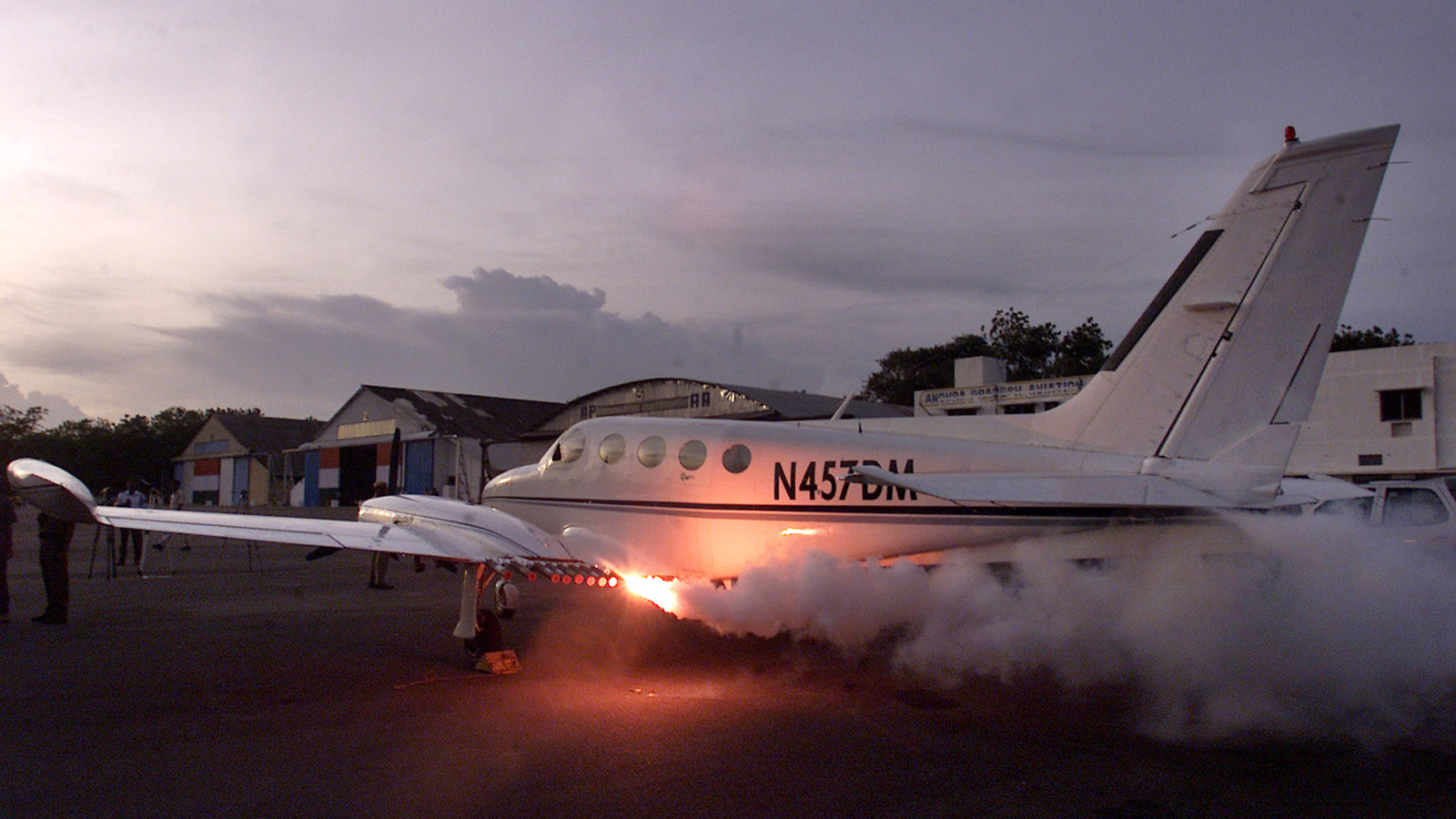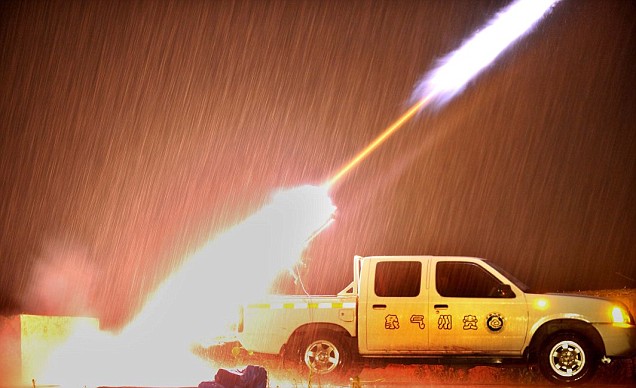
Cloud History, Cloud Thinking

“Do not suppose, because I call it a darkness or a cloud, that it is a cloud condensed out of the vapours that float in the air, or a darkness like that in your house at night when your candle is out. By intellectual ingenuity you can imagine such a darkness or cloud brought before your eyes on the brightest day of summer, just as, conversely, in the darkest night of winter you can imagine a clear shining light. Give up such errors; that is not what I mean. For when I say ‘darkness’ I mean an absence of knowing, in the sense that everything you do not know, or have forgotten, is dark to you, because you cannot see it with your mind’s eye. And for this reason it is not called a cloud in the air but a cloud of unknowing that is between you and your God.”
— Anonymous, The Cloud of Unknowing, Late 14th century
“Since there is no nonmetaphoric language to oppose to metaphors here, one must multiply antagonistic metaphors.”
— Jacques Derrida, Of Grammatology, 1967
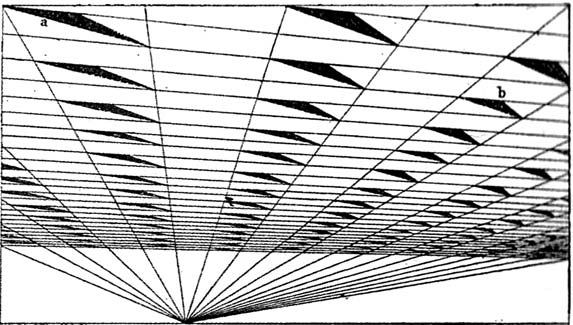
John Ruskin, Cloud Perspective: Curvilinear, Modern Painters, Vol. V, Plate LXV.
In 1884 the art critic and social thinker John Ruskin gave a series of lectures at the London Institution entitled The Storm-Cloud of the Nineteenth Century. Over the evenings of the 14th and 18th of February he presented an overview of descriptions of the sky and clouds drawn from Classical and European art, as well as the accounts of mountain climbers in his beloved Alps, together with his own contemporary observations of the skies of Southern England in the last decades of the Nineteenth Century.
What Ruskin called “plague-cloud” as well as storm-cloud “never was seen but by now loving, or lately, living eyes... There is no description of it, so far as I have read, by any ancient observer. Neither Homer not Virgil, neither Aristophanes nor Horace, acknowledges any such clouds among those compelled by Jove. Chaucer has no word for them, nor Dante; Milton none, nor Thomson. In modern times, Scott, Wordsworth and Byron are alike unconscious of them; and the most observant and descriptive of scientific men, De Saussure, is utterly silent concerning them.”
Ruskin’s “own constant and close observation” of the skies had led him to the belief that there was a new wind abroad in England and the Continent, a “plague-wind” that brought a new weather with it. Quoting from his own diary of July 1st, 1871, he relates that “the sky is covered with grey cloud;—not rain-cloud, but a dry black veil, which no ray of sunshine can pierce; partly diffused in mist, feeble mist, enough to make distant objects unintelligible, yet without any substance, or wreathing, or colour of its own...
“And it is a new thing to me, and a very dreadful one. I am fifty years old, and more; and since I was five, have gleaned the best hours of my life in the sun of spring and summer mornings; and I never saw such as these, till now. And the scientific men are busy as ants, examining the sub, and the moon, and the seven stars, and they can tell me all about them, I believe, by this time; and how they move, and what they are made of.
“And I do not care, for my part, two copper spangles how they move, nor what they are made of. I can’t move them any other way than they go, nor make of them anything else, better than they are made. But I would care much and give much, if I could be told where this bitter wind comes from, and what it is made of.”
He goes on to elucidate many similar observations: from strong winds out of nowhere, to dark clouds covering the sun at midday, and pitch-black rains which putrefied his garden. And while he acknowledges, in remarks that have been seized on by environmentalists in the years since, the presence of numerous and ever-growing industrial chimneys in the region of his observations, his primary concern is with the moral character of such a cloud, and the ways it seemed to emanate from battlefields and sites of societal unrest.
“What is best to be done, do you ask me? The answer is plain. Whether you can affect the signs of the sky or not, you can the signs of the times.”
Ruskin sought, in his analysis of the light which passed through cloud formations, to emphasise that the “’fiat lux’ of creation”—the moment when the God of Genesis says “Let there be light”—is also ‘fiat anima’, the creation of life. Light, he says, is “as much the ordering of Intelligence as the ordering of Vision”.
Just a few years previously, in 1880, Alexander Graham Bell first demonstrated a device called the photophone, a companion invention to the telephone, which enabled the first wireless transmission of the human voice. It worked by bouncing a beam of light off a reflective surface, which was vibrated by the voice of a speaker, and received by a primitive photovoltaic cell, which turned the light waves back into sound. The device was heavily dependant on clear skies for bright light, but even the weather could produce its own delights. Bell wrote to his father that “I have heard articulate speech by sunlight! I have heard a ray of the sun laugh and cough and sing! I have been able to hear a shadow and I have even perceived by ear the passage of a cloud across the sun’s disk.” Today, such light orders the data that passes beneath the ocean waves in the secure transport of fibre-optic cables, and orders the collective intelligence of the world.
In his preface to the published version of his lectures, Ruskin advised readers that “The following lectures, drawn up under the pressure of more imperative and quite otherwise directed work, contain many passages which stand in need of support, and some, I do not doubt, more or less of correction, which I always prefer to read openly from the better knowledge of friends, after setting down my impressions of the matter in clearness and as far as they reach, than to guard myself against by submitting my manuscript, before publication, to annotators whose stricture or suggestion I might often feel pain in refusing, yet hesitation in admitting.”
Caveat lector.
Lewis Fry Richardson was a mathematician and a Quaker. When war broke out in 1916, he registered as a Conscientious Objector and volunteered for the Friends’ Ambulance Unit attached to the 16th French Infantry Division. With him to the front lines he took papers he had gathered while working as Superintendent of the Eskdalemuir Observatory in Scotland. One of these was a summary of initial meteorological conditions over Central Europe for a single day: 20 May 1910. During the course of the war, when not on ambulance duty, Fry composed a series of mathematical operations which might predict the weather, and, with pen and paper, carried them out. The forecast took several months to compute, and proved wildly exaggerated given the known outcome of the day, but it proved the utility of the method: break the world down into a series of grid squares, and apply a series of mathematical techniques to solve the atmospheric equations for each square.
In Weather Prediction by Numerical Process, published in 1922, Richardson reviewed and summarised his calculations, and laid out a little thought experiment for achieving them more efficiently with the technology of the day. It is one of those experiments in which the abstractions of what we shall come to understand as digital computation is laid out at the scale of architecture—and in which “computers” are still human beings:
“After so much hard reasoning, may one play with a fantasy? Imagine a large hall like a theatre, except that the circles and galleries go right round through the space usually occupied by the stage. The walls of this chamber are painted to form a map of the globe. The ceiling represents the north polar regions, England is in the gallery, the tropics in the upper circle, Australia on the dress circle and the Antarctic in the pit.
“A myriad computers are at work upon the weather of the part of the map where each sits, but each computer attends only to one equation or part of an equation. The work of each region is coordinated by an official of higher rank. Numerous little ‘night signs’ display the instantaneous values so that neighbouring computers can read them. Each number is thus displayed in three adjacent zones so as to maintain communication to the North and South on the map.
“From the floor of the pit a tall pillar rises to half the height of the hall. It carries a large pulpit on its top. In this sits the man in charge of the whole theatre; he is surrounded by several assistants and messengers. One of his duties is to maintain a uniform speed of progress in all parts of the globe. In this respect he is like the conductor of an orchestra in which the instruments are slide-rules and calculating machines. But instead of waving a baton he turns a beam of rosy light upon any region that is running ahead of the rest, and a beam of blue light upon those who are behindhand.
“Four senior clerks in the central pulpit are collecting the future weather as fast as it is being computed, and despatching it by pneumatic carrier to a quiet room. There it will be coded and telephoned to the radio transmitting station. Messengers carry piles of used computing forms down to a storehouse in the cellar.
“In a neighbouring building there is a research department, where they invent improvements. But there is much experimenting on a small scale before any change is made in the complex routine of the computing theatre. In a basement an enthusiast is observing eddies in the liquid lining of a huge spinning bowl, but so far the arithmetic proves the better way. In another building are all the usual financial, correspondence and administrative offices. Outside are playing fields, houses, mountains and lakes, for it was thought that those who compute the weather should breathe of it freely.”
In a preface to the report, Richardson wrote: “Perhaps some day in the dim future it will be possible to advance the computations faster than the weather advances and at a cost less than the saving to mankind due to the information gained. But that is a dream.”
Later in life, Richardson turned his mathematical and pacifist mind back to the topic of war. Just as he had done with the weather, he applied differential equations and probability theory to the problem of conflict, as described in Statistics of Deadly Quarrels. In the Statistics, Richardson posited an idealised system of equations whereby the rate of a nation’s armament build-up is directly proportional to the amount of arms its rival has and also to the grievances felt toward the rival, and negatively proportional to the amount of arms it already has itself.
The solution to such a calculation, which might allow for useful conclusions to be drawn about the nature and causes of conflict, and thus its mitigation, has yet to be formulated.
Dawn, June 24, 1942: a select group of military and scientific personnel gather atop the 600-foot peak of Vroman’s Nose, a high promontory in Schoharie County, upstate New York. As the sun rises, a small puff of smoke rises from a generator in the distance, and quickly spreads out to fill the valley floor. A hundred gallons of super-heated lubricating oil is forced through a hot manifold and as the oil vapour meets the cold morning air it condenses into a dense white cloud of tiny particles. Within minutes, a smoke screen a mile wide, ten miles long, and some thousand feet deep totally obscures the valley.
The generator is the work of Vincent Schaefer, an engineer at General Electric Research in Schenectady, New York. Apart from a brief stint as a tree surgeon and itinerant landscape gardener, Schaefer has worked at the institute since 1922, and since 1933, as research assistant to Irving Langmuir and Katharine B. Blodgett. In 1941, following the German use of a smoke generator to hide the battleship Bismarck in a Norwegian fjord, Langmuir asks Schaefer to enlarge a small smoke generator he has developed for testing gas mask filters. Schaefer’s work exceeds all expectations. A new science, that of cloud physics, and a new technology, weather modification, is being born.
Among the military observers on Vroman’s Nose in 1942 was Vannevar Bush. During the Second World War, Bush was the director of the U.S. Office of Scientific Research and Development (OSRD), the primary vehicle for wartime military R&D. Bush was one of the progenitors of the Manhattan Project which led the development of the American atomic bomb. It was under contract with the OSRD that General Electric developed its smoke screens, and many later iterations of weather modification tools.
By the end of the war, Bush was deeply concerned by the direction in which the military had pushed scientific research, and by the ‘information explosion’ which arose from scientific production and technological application during wartime. In an essay called ‘As We May Think‘, published in The Atlantic in 1945, he wrote: “There is a growing mountain of research. But there is increased evidence that we are being bogged down today as specialization extends. The investigator is staggered by the findings and conclusions of thousands of other workers—conclusions which he cannot find time to grasp, much less to remember, as they appear. Yet specialization becomes increasingly necessary for progress, and the effort to bridge between disciplines is correspondingly superficial.”
Bush’s proposed solution to both these problems—the overwhelming information available to enquiring minds, and the increasingly destructive ends of scientific research—was a device which he called the “memex”. “A memex is a device in which an individual stores all his books, records, and communications, and which is mechanized so that it may be consulted with exceeding speed and flexibility. It is an enlarged intimate supplement to his memory. It consists of a desk, and while it can presumably be operated from a distance, it is primarily the piece of furniture at which he works. On the top are slanting translucent screens, on which material can be projected for convenient reading. There is a keyboard, and sets of buttons and levers. Otherwise it looks like an ordinary desk.”
In essence, and with the advantage of hindsight, Bush is proposing the electronic, networked computer. His great insight was to combine, in exactly the way a memex would enable anyone to do, multiple discoveries across many disciplines—advances in telephony, machine tooling, photography, data storage, and stenography—into a single machine. The incorporation of time itself into this matrix produces what we would recognise today as hypertext: the ability to link together collective documents in multiple ways and create new associations between domains of networked knowledge: “Wholly new forms of encyclopedias will appear, ready made with a mesh of associative trails running through them, ready to be dropped into the memex and there amplified.”
Such an encyclopaedia, readily accessible to the enquiring mind, would not merely amplify scientific thinking, but civilise it: “The applications of science have built man a well-supplied house, and are teaching him to live healthily therein. They have enabled him to throw masses of people against one another with cruel weapons. They may yet allow him truly to encompass the great record and to grow in the wisdom of race experience. He may perish in conflict before he learns to wield that record for his true good. Yet, in the application of science to the needs and desires of man, it would seem to be a singularly unfortunate stage at which to terminate the process, or to lose hope as to the outcome.”
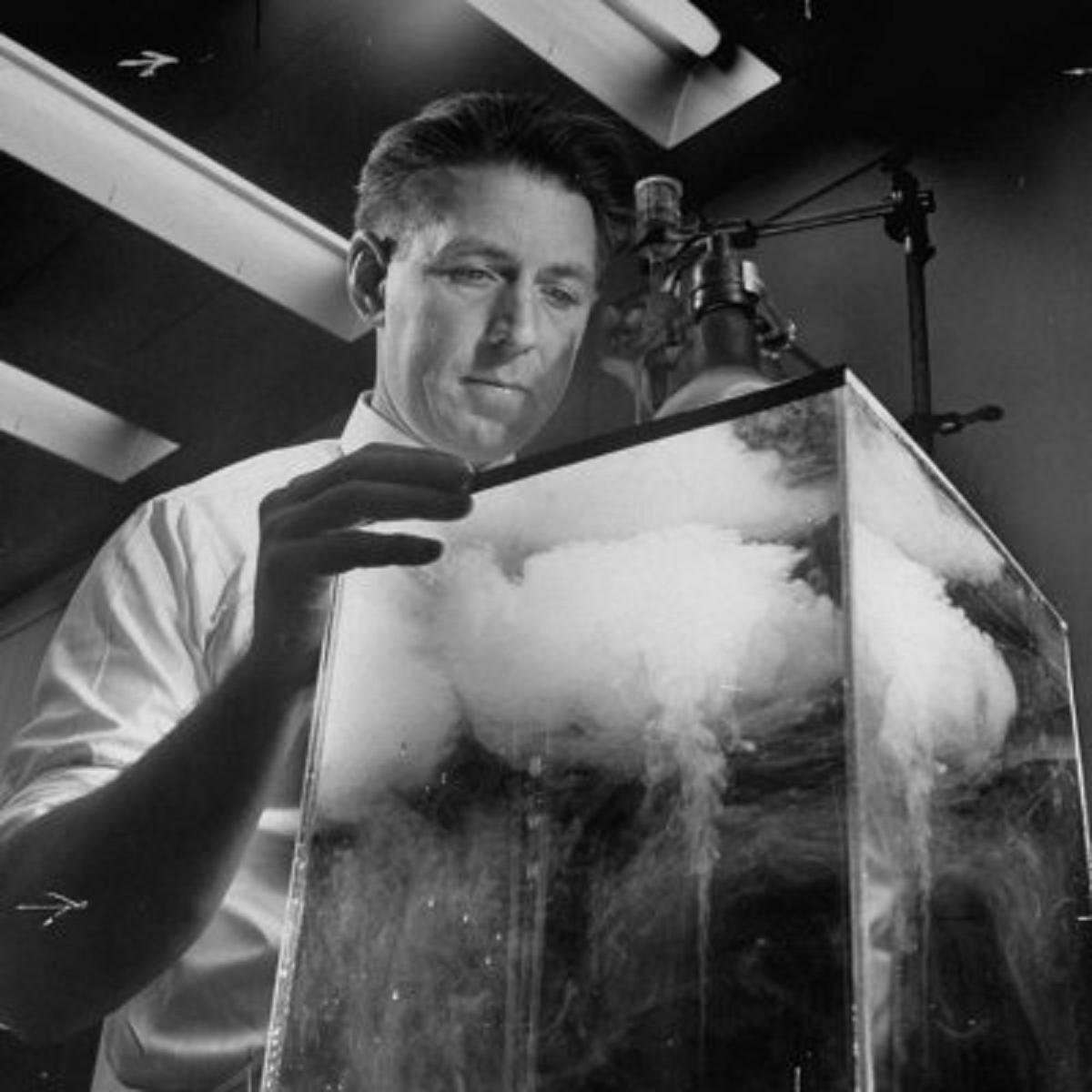
Vincent Schaefer in his laboratory at General Electric (GE News Bureau)
July 12, 1946: Vincent Schaefer is working in his laboratory at General Electric Research in Schenectady, New York. He has a home freezer open on a tabletop, and he is breathing into it to produce mist, as part of the laboratory’s ongoing research into the physics of clouds. But the freezer is not cool enough: the clouds will not form. In an attempt to speed up the cooling process, he takes a handful of dry ice and drops it into the open chamber.
Instantly, a cloud of ice blooms in the freezer cavity: millions of tiny ice crystals snap out of the air and, suspended for a brief second, fall like snow through the supercooled air.
“Serendipity”, Schaefer calls it. He takes the chunk of dry ice out and splits off a smaller piece, and drops it in again. The same thing happens. He does it over and over again until the fleck of ice is just a tiny grain: it produces the same effect each time.
The next week, he demonstrates his findings to Irving Langmuir, who is “just ecstatic”, and titles his own journal account of the discovery “Control of Weather”. The possibility is at hand not merely of producing new clouds, but of manipulating existing ones, at ever greater volumes. “We’ve got to get into the atmosphere”, he says.
At 9.30 am on November 13, Curtis G Talbot of the GE Flight Test Division takes off from Schenectady airport at the helm of a Fairchild Model 24 light aircraft. Aboard is Vincent Schaefer, “with a camera, 6 pounds of dry ice, and plans for attempting the first large scale test of converting a supercooled cloud to ice crystals.”
They fly East for an hour, climbing to 14,000 feet over Mount Greylock in western Massachusetts. On entering the clouds hanging over the mountain, Schaefer opens the window and empties his package of crushed dry ice into the slipstream. Within minutes, and from over fifty miles away in the control tower at Schenectady, Langmuir sees streamers of falling snow pouring onto the slopes of the mountain. The era of cloud seeding has begun.
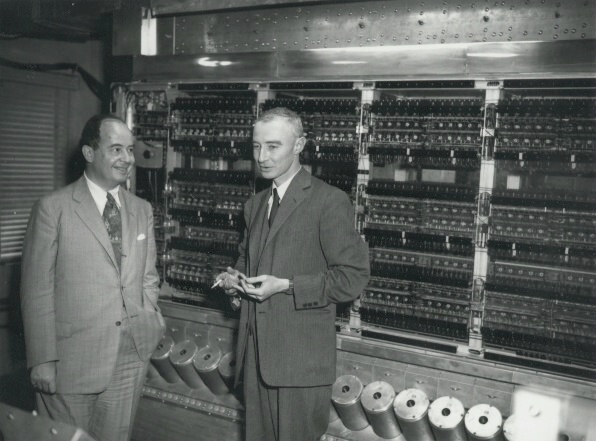
John von Neumann and Robert Oppenheimer standing in front of ENIAC (Electronic Numerical Integrator and Computer)
John Von Neumann first became interested in the possibilities of weather control in 1945, when he read a mimeograph entitled “Outline of Weather Proposal”, written by a researcher at the RCA Laboratories called Vladimir Zworykin. Von Neumann had spent the war consulting for the Manhattan Project, making frequent trips to the secret laboratory at Los Alamos in New Mexico and witnessing the first atomic bomb blast, codenamed Trinity, in July 1945. He was the main proponent of the implosion method used in the Trinity test and the Fat Man bomb dropped on Nagasaki, and helped design the critical lenses which focused the explosion.
Zworykin, like Vannevar Bush, had recognised that the information-gathering and retrieval abilities of new computing equipment, together with modern systems of electronic communication, allowed for the simultaneous analysis of vast amounts of data, but rather than focussing on human knowledge production, he anticipated its effects on meteorology. By combining the reports of multiple, widely-distributed weather stations, it might be possible to build an exact model of the climatic conditions at any particular moment. A perfectly accurate machine of this kind would not merely be able to display this information, but would be capable of predicting, based on prior patterns, what would occur next. Intervention was the next logical step:
“The eventual goal to be attained is the international organization of means to study weather phenomena as global phenomena and to channel the world’s weather, as far as possible, in such a way as to minimize the damage from catastrophic disturbances, and otherwise to benefit the world to the greatest extent by improved climatic conditions where possible. Such an international organization may contribute to world peace by integrating the world interest in a common problem and turning scientific energy to peaceful pursuits. It is conceivable that eventual far-reaching beneficial effects on the world economy may contribute to the cause of peace.”
In October of 1945, Von Neumann wrote to Zworykin stating that “I agree with you completely.” The proposal was totally in line with what Von Neumann had learned from the extensive research programme of the Manhattan Project, which relied on complex simulations of physical processes to predict real-world outcomes. “All stable processes we shall predict,” he wrote. “All unstable processes we shall control.”
In January 1947, von Neumann and Zworykin shared a stage in New York at a joint session of the American Meteorological Society and the Institute of Aeronautical Sciences. Von Neumann’s talk on “Future Uses of High Speed Computing in Meteorology” was followed by Zworykin’s “Discussion of the Possibility of Weather Control”. The next day, the New York Times reported on the conference under the headline “Weather to Order”, commenting that “If Dr Zworykin is right the weather-makers of the future are the inventors of calculating machines.”
The inventor of calculating machines par excellence in 1947 was von Neumann himself, who had founded the Electronic Computer Project at Princeton two years previously, with the joint support of the Institute of Advanced Sciences and RCA. The project was to build upon both Vannevar Bush’s analog computer, the Bush Differential Analyser, developed at MIT in the 1930s, and von Neumann’s own contributions to the first electronic general-purpose computer, the Electronic Numerical Integrator And Computer, or ENIAC. ENIAC was formally dedicated at the University of Pennsylvania on February 15, 1946, but its origins were military: designed to calculate artillery firing tables for the United States Army’s Ballistic Research Laboratory, it spent the majority of its first years of operation predicting ever-increasing yields for the first generation of thermonuclear atomic bombs.
Like Bush, von Neumann later became deeply concerned with the possibilities of nuclear warfare—and of weather control. In an essay for Fortune magazine in 1955, entitled “Can We Survive Technology”, he wrote: “Present awful possibilities of nuclear war may give way to others even more awful. After global climate control becomes possible, perhaps all our present involvements will seem simple. We should not deceive ourselves: once such possibilities become actual, they will be exploited.”

Glen Beck (background) and Betty Snyder (foreground) program ENIAC in Ballistic Research Laboratory building 328. (U.S. Army photo) [Source]
March 8, 1950: George Platzman stands, with four meteorologist colleagues, in a large but crowded room at the Ballistic Research Laboratory of the Aberdeen Proving Ground, Maryland. Covering three of the four walls are some 18,000 vacuum tubes, 70,000 resistors, 10,000 capacitors, and 6000 switches. The equipment is arranged into 42 panels, each about two feet across, three feet deep, and stacked ten feet high. It consumes 140 kW of power, radiating heat.
This is the ENIAC, moved from Philadelphia to Aberdeen in 1948, since when it has been operating almost continuously. To re-program it, it is necessary to reset hundreds of 10-pole rotary switches to new digits. The operators move between the stacks of equipment setting banks of these switches, connecting cables by hand, and checking hundreds of thousands of hand-soldered joints. (“The ENIAC itself, strangely, was a very personal computer”, will recall Harry Reed, a mathematician at Aberdeen, years later. “Now we think of a personal computer as one you carry around with you. The ENIAC was actually one that you kind of lived inside.”) Among the operators is Klári Dán von Neumann, John von Neumann’s wife, who wrote most of the meteorological code and checked the work of the others.
The meteorologists have already been working on the ENIAC continuously for almost a week, in eight-hour shifts supported by the programmers. Their intention is to perform the first automated 24 hour weather forecast. The boundaries of the calculation are the continental United States—a grid separated into 15 x 18 intervals—and the internal memory capacity of the ENIAC itself. The program consists of sixteen successive operations, each of which must be carefully planned and punched into cards, and which in turn produces a new output deck of cards which must be reproduced, collated, and sorted.
The entire run will end up taking nearly five weeks—although, as von Neumann will later point out, actual computation time will be about 24 hours, and, “one has reason to hope” that “Richardson’s dream of advancing computation faster than the weather may soon be realised.”
In the course of those five weeks, 100,000 IBM punch cards are produced, and a million multiplications and divisions performed. What strikes Platzman most deeply, and what he will recall most clearly decades later, is the strange interplay between electrical and mechanical components, and its resonance with scientific theory and technological process. The new era of virtualisation is a hybrid one: it absorbs both the physical and the digital, the climate both psychological and meteorological. Each acts on the other.
Operation 4: Calculation of the Jacobian. To perform this operation the ENIAC must read data from three different cards in sequence, shuffling each through the card reader at high speed, before pausing briefly to calculate the result. The card reader clicks audibly at each pass across the grid. Click Click Click—pause. Click Click Click—pause. In his head, Platzman hears the rhythm of a three-step jig, and begins to dance.
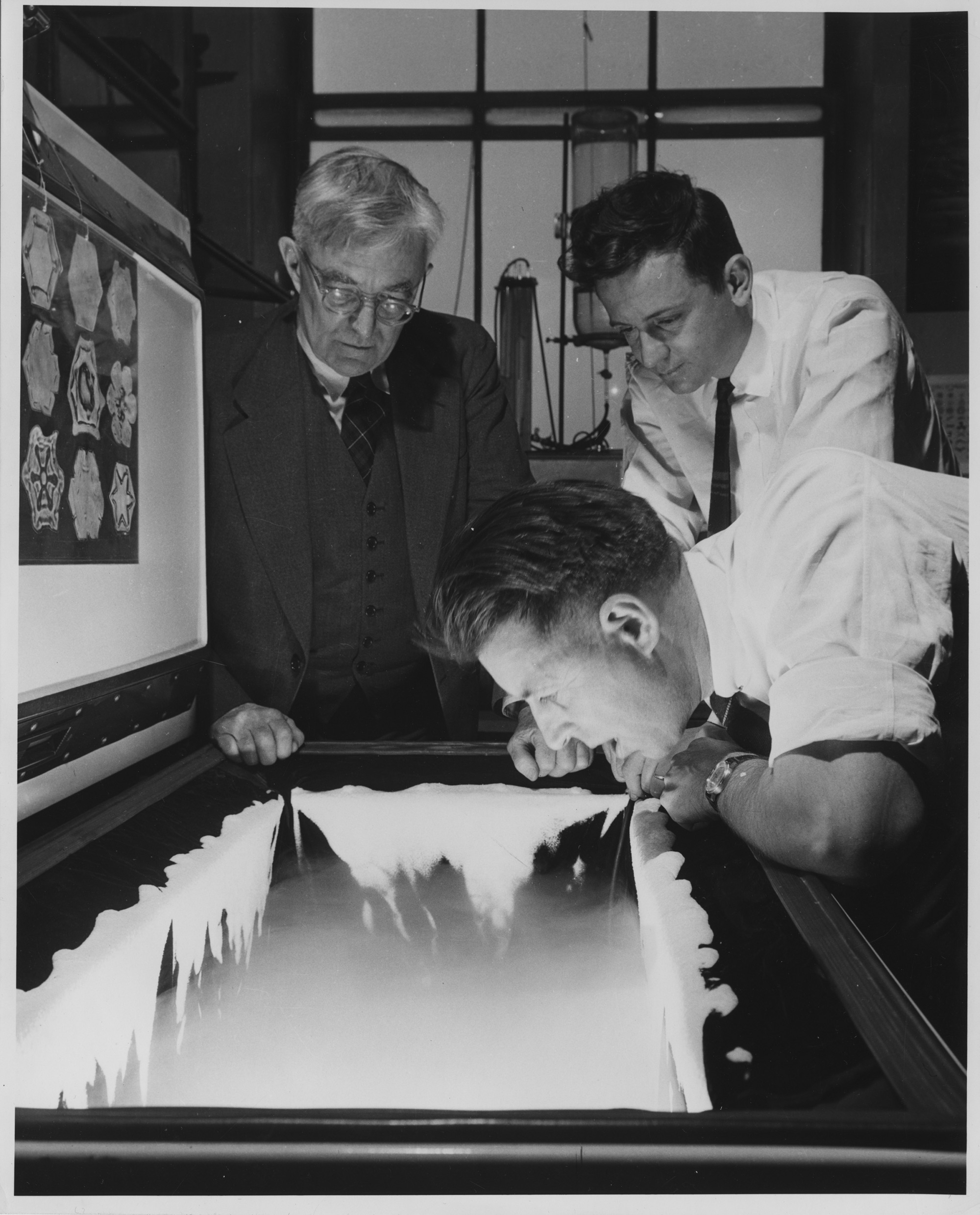
GE scientist Vincent Schaefer breathes a cloud into a freezer as colleagues Irving Langmuir and Bernard Vonnegut look on. (GE News Bureau)
In 1949, working alongside Langmuir, Blodgett, and Schaefer at General Electric Research was another atmospheric scientist and physical chemist, Bernard Vonnegut. Once Schaefer had shown the efficacy of dry ice in seeding cloud formations, Vonnegut was tasked with finding even more powerful alternatives.
The structure of ice is crystalline and hexagonal: what is known as “ice one h”. To find something that might have the same effect as dry ice, Vonnegut searched a chemistry handbook for substances with a similar structure. The most promising were metal iodides. Into one of Schaefer’s cold boxes he put first lead iodide, then silver smoke, and finally vaporised silver iodide. “Hallelujah!” he wrote in his notebook. The latter “worked like a charm... the ice box was just swimming with ice crystals—colossal numbers.”
Schaefer’s method changed the heat budget of a cloud—that is, it altered the balance between the incoming and outgoing heat of the cloud formation. Vonnegut’s silver iodide, on the other hand, changed the formative crystal structure of molecules within the cloud: a phase transition.
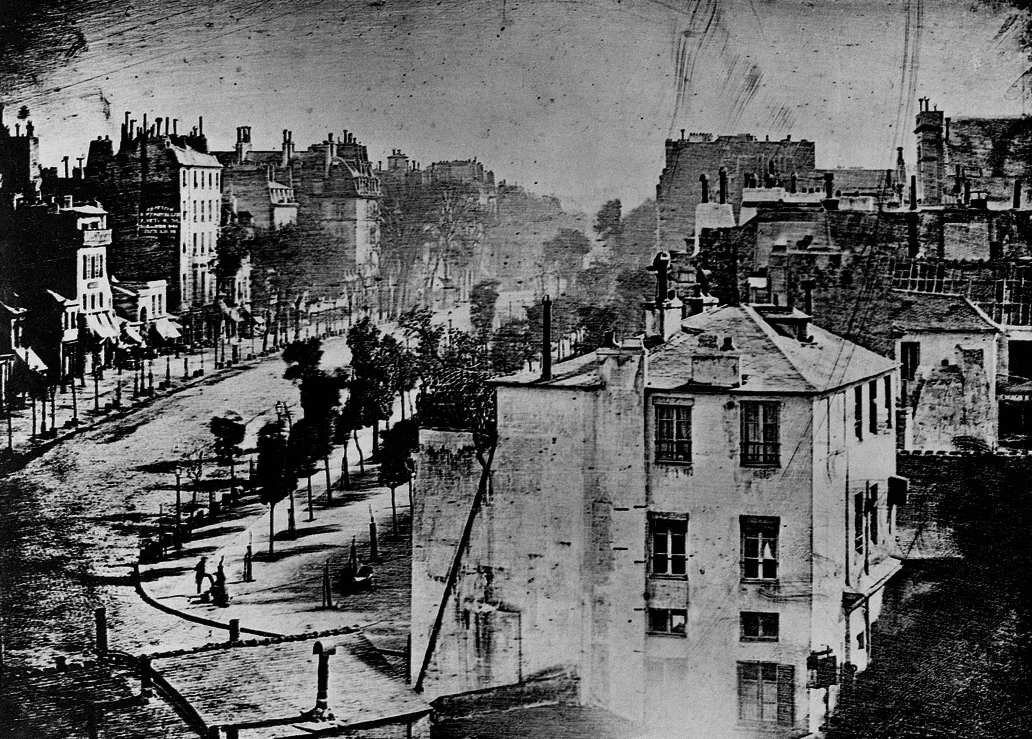
Boulevard de Temple (1838), Louis Daguerre: the earliest surviving photograph of a human being. [Source]
AgX: A side note on silver iodide
Silver threads itself through this story. In 1942, the Manhattan Project borrows 14,000 tons of it from the US treasury in order to build the massive calutrons at Oak Ridge. The production of enriched uranium for the first atomic bombs, including those dropped on Hiroshima and Nagasaki, required incredibly powerful magnetic fields, generated by wound-wire electromagnets. During the war, copper for these wires was in short supply, and silver’s high conductivity made it a natural replacement. Silver was withdrawn from the bullion depository at West Point, shaped into wires and busbars, and shipped under secure guard to the Oak Ridge National Laboratory, where it was wound around the vast, uranium-producing calutrons. When it came time to return the material at the end of the war, the machines were disassembled over sheets, and the floorboards beneath them burned to reclaim every fleck of precious metal.
But it’s the transformative use of silver which holds the most interest. Silver halides—of which silver iodide is one—were first identified by their photosensitivity; that is, they change their material form when exposed to light. It was this quality that led them to be investigated by Louis Daguerre, who produced his first photograph around 1835, by exposing a polished silver plate to the light, having first sensitised it with iodine fumes to create a thin coating of silver iodide. “I have seized the light,” Daguerre is supposed to have exclaimed: “I have arrested its flight!"
(It’s no accident that the canonical Vampire, the enemy of light and life, is defeated by silver, or that it remains unseen in silvered mirrors, and uncaptured by silver photography. Indeed, silver poisoning, known as Argyria, produces a deathly pallor in its victims, as the photosensitive element tarnishes beneath the skin.)
When a silver halide crystal is exposed to light, photons generate free-carrying electrons in the crystal structure which cause silver ions to form in the lattice. The more light, the more atomic silver emerges, clustering in the areas of greatest exposure, producing a latent image—that is, a fully formed, invisible but present image of reality immanent within the structure of the material. Development washes away the unexposed silver iodide, leaving the darkened silver image in place.
Silver iodide photography produced a revolution in seeing, and thus understanding, the world. The rays that affect silver salts overlap with, but are not the same as, the rays that the human eye sees. Early photographic plates are far more sensitive at the blues and violet end of the spectrum than they are at the red end. There has always been the possibility of capturing, on a photographic plate, marks of things we cannot see. Through its sensitivity to extrasensory wavelengths, and the ability to detect incredibly faint objects—such as distant stars—through long exposure, silver halide photography changed the consistency of the detectable universe.
Weather control through the use of silver iodide fulfils the promise of image-making to transform our understanding of, and thus agency in, the world. From representation of the environment and ourselves within it, with all its latent possibilities of apprehension and control, to direct manipulation of the environment, and thus ourselves.
A further side note: when cloud seeding takes place, it rains silver.
Bernard Vonnegut had a brother: Kurt. In 1949, the younger Vonnegut was working as a publicist at GE Research and closely following his brother’s research. His first novel, Player Piano, published in 1952, described a future society where mechanisation had eliminated the need for human labourers, driven by the machinations of an artificially intelligent supercomputer, the EPICAC. His fourth, Cat’s Cradle, published in 1963 after he left GE, detailed the invention by the Manhattan Project of a material called “ice nice”, a grain of which causes water to freeze instantly. He also took inspiration for the substance from Irving Langmuir, who had tried to convince HG Wells, during a visit to GE in 1932, to write a novel about a form of solid water which would be solid at room temperature. Wells, apparently, was not inspired.
Asked years later why he started writing science fiction, Kurt Vonnegut responded: “The General Electric Company was science fiction”.
In Slaughterhouse-Five, probably his most famous novel, published in 1969, Vonnegut relates a conversation he had with Harrison Starr, the producer of Zabriskie Point. When he finds out that Vonnegut is working on an anti-war book, he responds “Why don’t you write an anti-glacier book instead?”
“What he meant, of course, was that there would always be wars, that they were as easy to stop as glaciers. I believe that too.”
June 14, 1949: General George Kenney addresses an alumni meeting at the Massachusetts Institute of Technology, in support of its call for more funds to invest in research. The research he advocates is primarily military in nature, and its means technological. “Tougher and more heat-resistant metals,” higher rates of fire “and much higher muzzle velocities in aircraft machine guns,” radars “smaller, lighter and having a lot more range and a better definition,” devices “to launch and land aircraft in shorter distances,” better fuel for jet engines and rockets, and “radio control” for guided missiles.
Kenney also suggests that sound might be used as a new weapon, saying: “An airplane equipped with a sort of super dog whistle conceivably could fly around a city for awhile and upset the nervous systems of the whole population. Light waves offer a similar field. Below the infrareds and above the ultraviolets there may be weapons of devastating as the atomic bomb.”
But Kenney’s greatest enthusiasm is reserved for the possibilities of weather modification. If rain could be kept “from falling where it has been falling for ages,” he declares, it is conceivable that “the nation that first learns to plot the paths of air masses accurately and learns to control the time and place of precipitation will dominate the globe.”
It is not without the bounds of possibility, he thinks, that “if man tries hard enough he may even turn the globe into a cinder some day.”
On October 13 1947, GE Research collaborated with the US Army Signal Corps, the Office of Naval Research, and the US Air Force on the first instrumentalisation of cloud seeding: Project Cirrus, an attempt to modify a hurricane. Hurricane King, the eighth of the Atlantic season, was 400 miles off the East Coast and heading out to sea after already wreaking havoc in southern Florida. Shortly after the GE team dumped 180 pounds of dry ice into the heart of the storm it made a sudden hairpin turn and headed west, crashing back into the coast of Georgia and causing substantial damage.
Project Cirrus was succeeded by Project Stormfury, a large-scale, decades-long attempt to modify Atlantic hurricanes (and which Fidel Castro believed was a military project to turn counterrevolutionary hurricanes onto Cuba). It failed spectacularly, as tropical hurricanes contain little of the supercooled water found in typical storm clouds, and which can be affected by cloud seeding. But it did inspire military planners to return to the offensive possibilities of making it rain.
The 54th Weather Reconnaissance Squadron—slogan: “Make Mud, Not War”—operated from March 1967 until July 1972, out of Udorn Air Base in Thailand. Its target was initially the Laotian panhandle, and gradually expanded to cover North and South Vietnam, and northeastern Cambodia. Their cargo was silver iodide canisters, fixed in rows on the fuselage of their aircraft and ignited over the target area. Three C-130 Hercules aircraft accompanied by two F-4C Phantom interceptors made two sorties a day during the rainy season, and claimed to have extended the monsoon by an average of 30 to 45 days, flooding lines of communication, wearing down missile batteries, and turning the Ho Chi Minh Trail into a washed out mudslide.
Operation Popeye was classified top secret but references leaked in the Pentagon Papers, and were followed up by Seymour Hersch in an article in the New York Times in July of 1972, which noted differences of opinions within the military and the CIA over the use of weather as a weapon. “What’s worse,” one official was quoted as asking, “dropping bombs or rain?” Operations ceased two days later.
August 16, 1952: In the mess room of Cranfield Aerodrome in Bedfordshire, a group of RAF men are drinking toasts to a huge success. Earlier that day, they had flown a series of sorties over the county. The day had been bright, but full of great floating cumulus clouds. Alan Yates, one of the pilots, had flown up into the clouds and seeded them with silver iodide. Circling back down and taking readings as he went, he saw a sodden-looking countryside below.
Operation Cumulus, as the project was officially known, had been operating for two weeks, and produced amazing results. Bedfordshire experienced its heaviest August rains in decades, and showers spread out across Southern England.
As they were drinking, the base telephone rang. When news of its message spread around the room, a stony silence fell on the company. A storm of tropical intensity had broken over South-West England. Nine inches of rain had fallen on the already saturated soil of Exmoor in twenty four hours, and ninety million tonnes of water swept down the narrow valley of the East Lyn. The river burst its banks, sweeping away bridges and buildings in the village of Lynmouth. 34 people died, many of them swept out to sea by the rushing waters.
Operation Cumulus was shut down immediately, and evidence of its existence was concealed for fifty years.
The dream of Richardson and von Neumann—that of “advancing computation faster than the weather”—was realised in April of 1951 when Whirlwind I, the first digital computer capable of real-time output, went online at MIT. Project Whirlwind had started as an attempt to build a general-purpose flight simulator for the Air Force: as it progressed, the problems of real-time data gathering and processing had drawn in interested parties concerned with everything from early computer networking to meteorology.
One of Whirlwind I’s core functions was to simulate aerodynamic and atmospheric fluctuations, in what amounted to a weather-prediction system. This system was not only real-time but, of necessity, networked: connected to and fed data by a range of sensors and offices, from radar systems to weather stations.
Whirlwind’s design was heavily influenced by ENIAC; in turn, it laid the groundwork for the SAGE, the vast computer system which ran North American Air Defense from the 1950s until the 1980s, and which is best memorialised in the vast, paranoid aesthetic of Cold War computing systems from Dr Strangelove to WarGames.
Towards the end of Turing’s Cathedral: The Origins of the Digital Universe, George Dyson writes: “A fine line separates approximation from simulation, and developing a model is the better part of assuming control. So as not to shoot down commercial airliners, the SAGE (Semi-Automatic Ground Environment) air defense system that developed out of MIT’s Project Whirlwind in the 1950s kept track of all passenger flights, developing a real-time model that led to the SABRE (Semi-Automatic Business-Related Environment) airline reservation system that still controls much of the passenger traffic today. Google sought to gauge what people were thinking, and became what people were thinking. Facebook sought to map the social graph, and became the social graph. Algorithms developed to model fluctuations in financial markets gained control of those markets, leaving human traders behind. “Toto,” said Dorothy in The Wizard of Oz, “I’ve a feeling we’re not in Kansas anymore.””
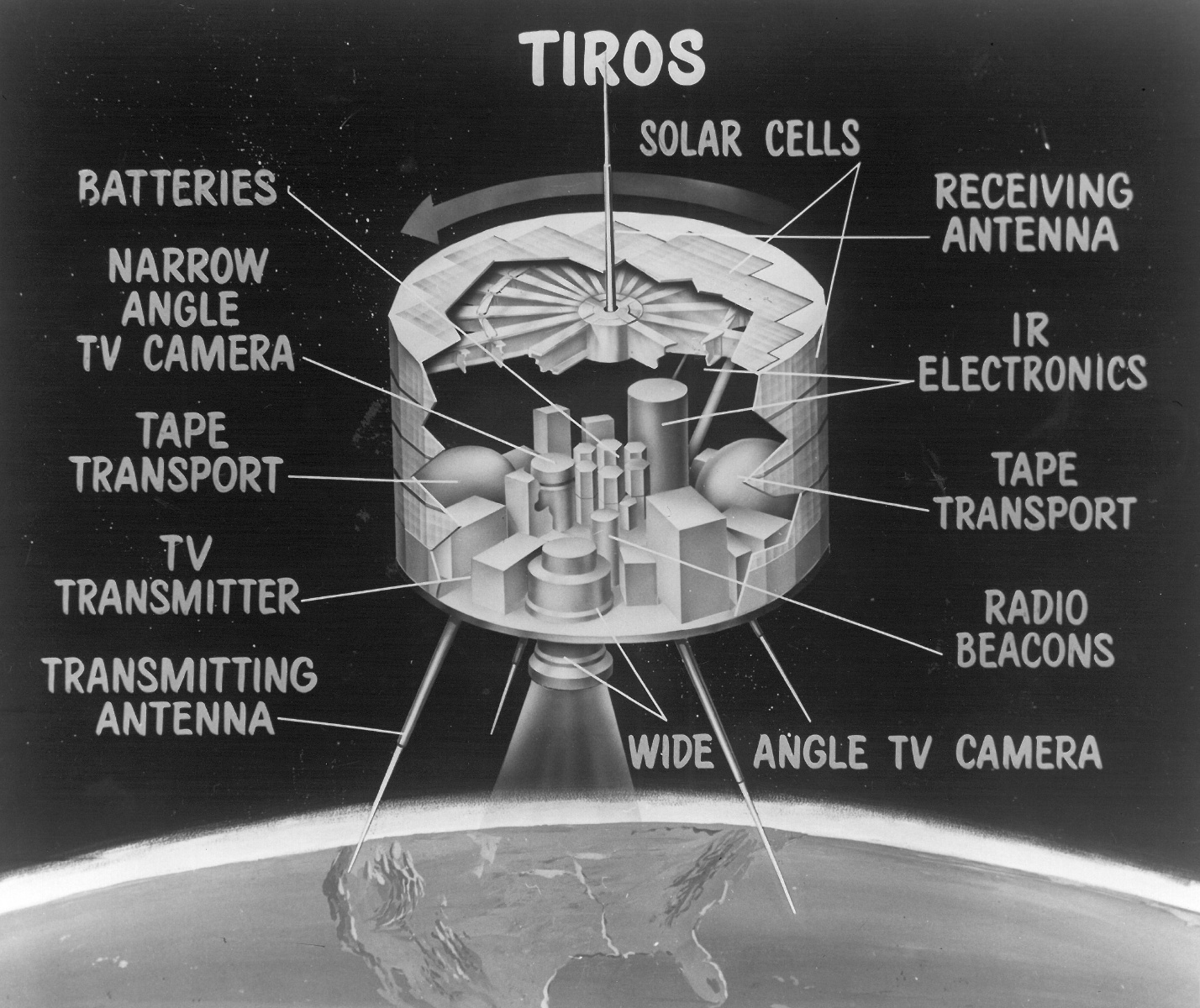
TIROS-1, 1960 (NASA)
In 1954, Harry Wexler, chief of the US Weather Bureau, received a letter from a Science Fiction writer. Wexler was a well-known figure in the meteorological community, having made history as the first scientist to deliberately fly into the eye of a hurricane to collect data. The writer was the British inventor, futurist, and novelist Arthur C. Clarke.
Clarke published his first long look at the future under the heading “Extra-Terrestrial Relays — Can Rocket Stations Give World-wide Radio Coverage?” in 1945, in the British magazine Wireless World, but he was already well aware of the electromagnetic implications of weather control. Clarke had worked on ground-controlled approach radar during the war, a critical technology which allowed returning bomber pilots—and, subsequently, untold millions of civilian pilots and passengers—to find safe haven during adverse weather. He was also present during several FIDO tests, when the RAF spectacularly burned fuel in long trenches to disperse fog: possibly the most expensive but definitely the most successful use of weather modification during war time.
Clarke’s letter to Wexler in 1954 concerned a new proposal: the use of artificial satellites to observe the weather. Since the 1920s, it had been recognised that radio signals could be bounced off relays in geostationary orbits, but the development of unmanned computation brought this possibility into reality. We didn’t need manned space stations any more; automation could fit the requirements. Long before Apollo staked a claim for human exploration of the cosmos, the role of robots in space—and, subsequently, in other spheres of life—was being acknowledged.
As a result of this correspondence, Wexler pushed hard for the development of TIROS, the first satellite capable of remote sensing the Earth; that is, looking down, from space, onto the planet. TIROS-1, launched in 1960, was the first satellite (that we know of) to broadcast near-live images to the ground, mapping the progression of tropical storms, cold fronts, and depressions across the face of the globe, naming the tempests, and giving warning and opportunity to those who reside in its path.
TIROS was the first in a wave of Earth observation satellites which have radically changed the way we perceive the planet we inhabit. The ability to view the Earth from the apparently dispassionate vantage point of orbit radically reconfigures the human sensorium: like the technological networks which connect us, it offers us an extrasensory perception of ourselves, a superpower somewhere between the view of God, and telepathy. We see the world laid out, not as oppositional alignments of man versus her environment—or man versus machine—but as a total integration, an entangled web within which the things we build become revelatory tools for assessing and advancing our own agency—us, and our environment, and our machines.
In 1962, Wexler was an advisor on Project Highwater, a pair of test flights on NASA’s new Saturn rocket, which were deliberately destroyed in the upper atmosphere to release almost a hundred tonnes of water into the ionosphere, a hundred miles above the earth’s surface. The idea was to simulate the release of potentially dangerous propellant in the event of a launch failure. The result was an ice cloud which spread out to several miles in diameter, and disrupted radio communications on the ground.
In the same year, he gave a series of speeches entitled “On the Possibilities of Climate Control” in which he noted that weather control was becoming respectable to talk about. John F Kennedy’s 1961 speech to the United Nations proposed “cooperative efforts between all nations in weather prediction and eventually in weather control”; Nikita Kruschev said much the same thing in his report to the 1961 Supreme Soviet.
Before going into the details of several proposed weather modification programmers, Wexler gave a stark warning. He cited rising carbon dioxide emissions from industry, and the use of chlorine and bromine in rocket fuel as examples of indirect weather control. This tinkering might result in “rather large-scale effects on general circulation patterns in short or long periods, even approaching that of climatic change. Make no mistake,” he said, “We are in weather control now.”
29 October 1969, 10:30pm: Charley Kline, a grad student at UCLA, sits at a teletype terminal in the institution’s computer labs. “L”, he types, then “O”. And then the system crashes. It takes another hour to persuade the machine—a room-sized Sigma 7 mainframe—to accept the full command: “LOGIN”. But when it does it triggers the connection to another computer at the Stanford Research Institute three hundred and fifty miles away along the Californian coast. This is the birth of the ARPANET, the network which inspired and eventually became the internet: the network of networks.
The term “internet” comes from a subsequent paper by Vint Cerf, published in 1974, which defined a common protocol to bring computer networks together. The term “cloud”, to signify the use of remote computing resources, including processing and data storage, accessed via the internet, originates in the diagrams of early network engineers. Drawing out the map of computers and their relationships, the looping line surrounding groups of servers signifies distant agglomerations of vast power that are not suitable for elaboration or investigation.
Charley Kline’s connection is the moment when the ENIAC and the machines like it start to reach out across the Earth, to connect to one another, to satellites and sensors. It is also the moment in which what we might call “computational thinking” becomes more than philosophical: it becomes architectural and infrastructural.
Since the Enlightenment, we have believed that by gathering empirical and objective data alone we can make sense of the world. Sense-making makes power: that which orders the world determines how we understand and make use of it. It is this progression from understanding to agency which we see in the history of meteorology: a progression from weather forecasting, to weather control.
Cloud computing is the full spectrum deployment of computational thinking to the world, and the internet makes of these clouds a single, vast, planetary weather system.
Just as the cognitive effects of computational thinking have accompanied the spread of digital technologies from military and technical agencies into wider society, so the technologies of cloud seeding and weather modification have, over time, served other political uses.
For decades, the Soviet Union used cloud seeding to guarantee good weather for military parades and national holidays. Weather Control was—and still is—the responsibility of the Central Aerological Observatory, founded by Stalin in 1941. The work of the CAO included radar development, weather forecasting, satellite design—and hail suppression, fog dispersal, and rain-making.
It was airplanes designed by the CAO which made repeated flights over the Gomel region of rural Belarus in April 1986. In the nineties, Alan Flowers, a British scientist studying the fallout from the Chernobyl disaster found unusual patterns of radiation in the area, which was some hundred miles from the nuclear reactor. Speaking to local residents, who knew nothing about the disaster at the time, they recalled that around that time many small planes trailing coloured smoke were seen over the area, and their appearance was followed by heavy, black rains.
The Soviet authorities, who did not publicly acknowledge that the accident at Chernobyl had occurred for two days, were monitoring weather conditions which were sending heavily radioactive clouds northeast from the Ukraine towards heavily populated cities in Russia, including Moscow. They took the decision to force the weather, sending Air Force pilots equipped with Silver Iodide into the clouds. Under conditions of Soviet secrecy, the population of Gomel was not warned that cloud seeding was taken place, and no mitigation strategy, such as the distribution of potassium iodide tablets against radiation sickness, was undertaken. Those on the ground were exposed to radiation twenty to thirty times higher than normal, causing many, particularly children, to develop leukemias and thyroid cancers—but potentially saving millions more from exposure elsewhere.
Flowers was subsequently expelled from Belarus in 2004 for publicly discussing the operation, just a few years before Russian pilots spoke out publicly about it. On the website of the Central Aerological Observatory a single line notes: “Suppression of cloud development method has been used to reduce rainfall in the aftermath of the Chernobyl accident.” No one can really change the weather, but we can decide where it falls.
February 21st 2001: the fourteen members of the International Olympic Committee’s Evaluation Committee arrived in Beijing for the first of a series of site visits to candidate cities for the 2008 Olympic Games. While concerns had been raised in the international press about China’s Human Rights record and its suitability for hosting the Games, one of the IOC’s main concerns was the high levels of pollution in the city. In response to these concerns, the Chinese government had planned 3,000 acres of forested parkland to surround the Olympic Stadium and the athlete’s village, the closure or removal of polluting factories to the edge of the city, and the switching of petrol buses and taxies to cleaner-burning natural gas. But they also had another tool at their disposal.
In the run-up to the IOC’s visit, the Beijing Weather Modification Office went into operation, seeding clouds in the vicinity to produce heavy rainfall over the city in the days preceding the Committee’s arrival. The result was startling: the smog cleared, the streets were clean and sparkling, and five months later Beijing was elected as the host city for 2008.
China’s weather modification programme is considered to be the largest in the world, employing more than 40,000 people, with an arsenal of 7,000 cannons and 4,687 rocket launchers. In Central China, where agricultural land is subject to threats from both hail and drought, mobile weather modification units consist of arrays of rocket launchers mounted on the beds of pick-up trucks and the roofs of 4x4s. These units are cheaper to operate than wide-scale dispersal from aeroplanes, and have been credited with averting disaster numerous times. Like the Soviets, the Chinese government also deploys its weather modification techniques for important state events, such as the annual National Day parade. The technique is now so sophisticated that weather “forecasts” become mere formalities—reporting from Beijing in 2007, the Guardian reported that: “Weather forecasters said it would rain around midnight and, hey presto, the first drops of rain started to fall almost on the dot.” Harry Wexler’s vision of weather control had indeed been achieved.
The Weather Modification Office went on the offensive again for the Games themselves: as many commentators noted the Opening Ceremony was preceded by an artillery barrage, as some 1,110 silver iodide rockets were launched into the sky to break up a threatening weather front. The rockets were fired over four hours from 21 sites around the city, and the rain was held off. Despite ongoing questions about both human rights and environmental pollution, the Games were widely judged to have provided a huge boost to China’s international image, and its internal political control.

Not a Conclusion: Cloud Thinking
To live in the world today is to live under, and within, a cloud. The planetary scale of the climate has finally been replicated in the planetary scale of our information systems, which encircle the globe. Both of these systems are, quite literally, out of control.
In the case of the weather, anthropogenic climate change is now irreversible, and is driving increasingly violent change, both within geophysical processes, and within societies. Climate-driven wars and mass migrations are already a reality, as are effects which can be experienced more immediately, such as increased turbulence in the atmosphere.
And yet, despite the direst warnings and desperate urgings of scientists, we seem unable to respond to this crisis. Writing in the New York Times, the founder of the Global Weather Corporation, a corporation using advanced data processing to improve weather prediction, forecasts “A New Dark Age”, in which the exponential disruptions produced by climate change drastically reduce our ability to predict the future. We will lack the tools and the understanding to deal with emergent, chaotic conditions, and the times we live in will be considered the point at which we passed through “peak knowledge” about the planet we live on. In response, the author proposes massive technological investment in weather monitoring and prediction: more data, more processing, more computational knowledge of the world.
Meanwhile, the empirical case for computational knowledge itself is failing. In the pharmacological sciences, which have spent decades automating and datafying the long process of drug discovery, results have fallen precipitously, giving rise to a new conception of computational effects. Turning Moore’s Law, which states that processing power increases exponentially over time, on its head, Eroom’s Law acknowledges that progress is being made ever more slowly and less effectively by the pure application of computation. In the battle between surveillance agencies and transparency activists, the fight for the control of the raw data which supposedly produces actionable knowledge about the world results not in improved security, but in mass oppression and paranoia. The accompanying corrosive culture of secrecy and revelation doubles down on computational knowledge to reinforce the idea that pure information is sufficient for calculating the state of the world, and thus acting meaningfully within it.
At the philosophical scale, the abundance of information and the plurality of worldviews now accessible to us through the internet is not producing a coherent consensus reality, but one riven by fundamentalist insistence on simplistic narratives, conspiracy theories, and post-factual politics. We do not seem to be able to exist within the shifting grey zone revealed to us by our increasingly ubiquitous information technologies, and instead resort to desperate modification strategies, bombarding it from the air with images and opinions in order to disperse and clarify it. It’s not working.
A deep sense of unease permeates the atmosphere. “Weather,” as the artist Roni Horn has observed, “is the key paradox of our time. Weather that is nice is often weather that is wrong. The nice is occurring in the immediate and individual, and the wrong is occurring systemwide.” Crisis is the new normal.
The cloud, however, remains a model of the world, just not the one we have taken it to mean. The apparent growth of crisis is, in part, a consequence of our new, technologically-augmented ability to perceive the world as it actually is, beyond the mediating prism of our own cultural sensorium. The stories we have been telling ourselves don’t bear out. They’re weak all over. The cloud reveals not the deep truth at the heart of the world, but its fundamental incoherence, its vast and omniferous unknowability.
In place of computational thinking, we must respond with cloud thinking: an accounting of the world which reclaims the recognition and the agency of unknowing. Aetiology is a dead end. The cloud, our world, is cloudy: it remains diffuse and forever diffusing; it refuses coherence. From our global civilisation and cultural history arises a technology of unknowing; the task of our century is to accommodate ourselves with the incoherence it reveals.


